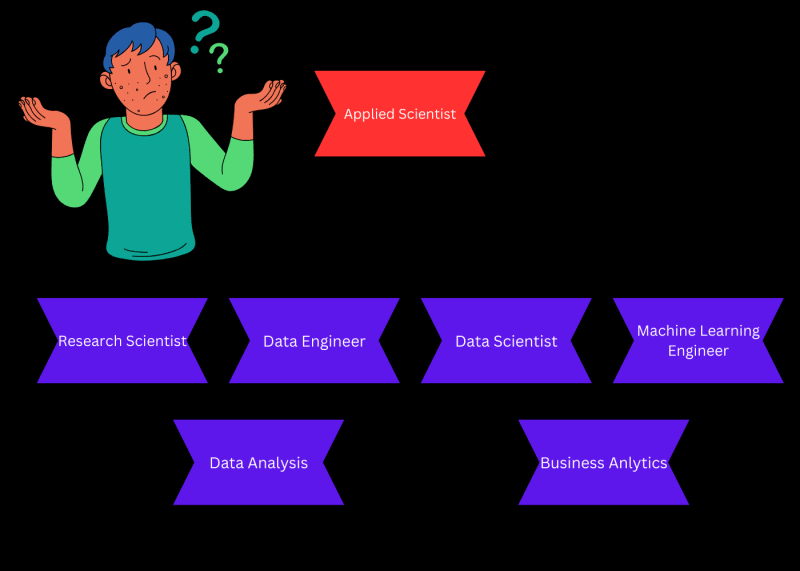Noise about Applied Scientists has started to rise in the data field. Even, Amazon has been hiring them for a long time.
Data Science is an evolving domain, which brings a lot of exciting and complex things to the data field. As data science evolves, it will bring different aspects and working modules with it. Gone are the days, when a data scientist had to be more efficient in building machine learning Algorithms, now only utilizing the pre-existing models.
‘Woah’
That is a Bold Statement. But, it is in the realm of reality.
Okay, Let’s lay the foundation of understanding, being an Applied Scientist.
Table of Contents
Who is an Applied Scientist?
What does an Applied Scientist do?
Difference Between Applied Scientist and Data Scientist
Examples of Work Differences
Who is an Applied Scientist?
A scientist who focuses on the practical application of scientific knowledge to solve real-world issues is known as an Applied Scientist. They utilise scientific methods to create and test new ideas before working to put those ideas into action in the actual world. Applied Scientists work in a variety of fields such as technology, healthcare, energy, and manufacturing.
Skills Needed for Applied Scientist
Excellent analytical and problem-solving abilities
The capacity to deal with and analyse massive datasets
Python, R, or MATLAB (Not Much) programming abilities are required.
Understanding of machine learning and artificial intelligence
Ability to explain technical topics to both technical and non-technical audiences
Ability to operate both individually and collaboratively
Tools and technologies
Specific Tools and Technologies Applied Scientists Use:
Laboratory equipment: Applied scientists working in chemistry or biology may gather and analyse data using laboratory equipment such as microscopes, pipettes, and centrifuges.
Engineering software: Applied scientists working in the field of engineering may create and model products and systems using engineering software such as CAD software or FEA software.
Manufacturing software: production applied scientists may utilise manufacturing software such as CAM software or ERP software to design and optimise production operations.
What does an Applied Scientist do?
Improve the performance of software and hardware systems by developing new algorithms and machine learning models.
Analyse data to spot trends and patterns that may be utilised to enhance corporate operations, create new products, or solve societal issues.
Create and carry out experiments to put fresh theories and hypotheses to the test.
Create and test updated gadgets and technologies.
Collaborate with engineers and other experts to incorporate new scientific findings into commercial services and products.
It seems a bit odd as if we are going the same path as a data scientist. But there is a difference between the two. Let’s find out.
Difference Between Applied Scientist and Data Scientist
Here’s a simplified explanation of the difference between data science and applied science:
Imagine a medical research team discovering a new drug for a rare disease. To determine its safety and effectiveness, a lot of data needs to be collected and analyzed.
Data scientists specialize in collecting, cleaning, and analyzing data using statistical and Machine Learning techniques to extract valuable insights. After analyzing the data, data scientists share their findings with researchers and assist in interpreting the results. This helps researchers make decisions about the drug’s development, including whether to proceed with clinical trials.
On the other hand, An applied scientist may collaborate with researchers to create a new machine-learning model for identifying patients who are probably to react to the medicine. The applied scientist may also collaborate with the researchers to create a novel clinical trial design that is more efficient and successful in establishing the drug’s safety and efficacy.
In short, data scientists are concerned with inventing and implementing new data science techniques, whereas applied scientists are concerned with using current methods and tools to tackle specific issues.
To help you grasp the gap between data scientists and applied scientists, consider the following analogy:
Data scientists are similar to chefs in that they create new recipes and culinary techniques.
Applied scientists are similar to cooks in that they employ pre-existing recipes and culinary techniques to make delectable meals for their consumers.
Examples of Work Differences
Here are some examples of work differences between Data scientists and Applied Scientists
A data scientist at a tech firm may create a machine learning model to predict customer turnover using Python and scikit-learn.
A healthcare company’s applied scientist may use R and TensorFlow to create a deep-learning model to identify illnesses from medical photos.
A data scientist in finance may utilise Hive and Spark to analyse enormous datasets of financial transactions to uncover patterns and trends.
A manufacturing applied scientist may use Hadoop and Python to create a system to forecast machine failures in a manufacturing facility.
These are some examples of work differences between data scientists and Applied scientists, the specific tools and technologies may vary depending on the nature of the project, company and problem.
Final thoughts
Although, Applied scientists seem like enjoying a two-way journey on a single-way ticket, but this is not the case. You ask Why is that? Well, PhDs in subjects like computer science, mathematics, physics or engineering are a common endeavour for applied scientists. So, they already have a profound knowledge of their domains. But, at the same time, it is not necessary as there is always a focus on skills and domain knowledge.
Hurrah, You read it ALL!
If you have any questions, comment and I will be happy to answer your queries.
Thanks and Happy Learning!





Top comments (0)